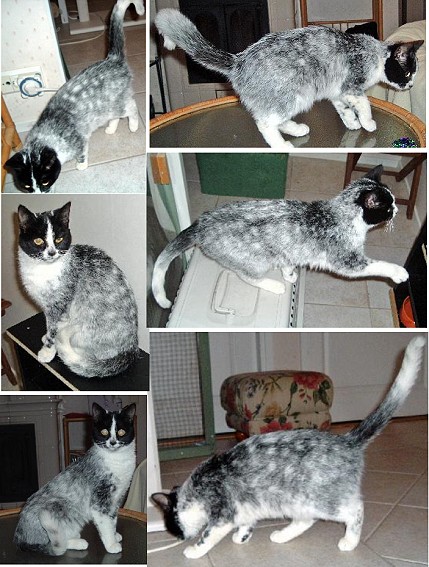
ROAN: FINNISH MUTATION - A VARIANT KARPATI PATTERN
This phenotype seems fairly uniform, but all of the reported cats in Finland were either sterilised or were infertile due to inbreeding. In 2007, I wrote that it would be exciting to be able to breed and investigate this mutation. In 2023, the phenotype turned up in pedigree cats, in a breeding programme, and with DNA tests for colour and pattern genes.
2007 – 2017 – AN UNKNOWN MUTATION
Most of the original cats were found in Finland, with one turning up around 1000km away in a town in Russia. All were found as stray or feral cats. In general the torso has a mix of black and white fur giving a roan effect. The legs and tail are white with black dapples. The head is solid black with a white inverted V-blaze and a black nose. Some of the cats also have evenly spaced, well contrasting white spots on the torso. The shoulders and the front of the forelegs is darker than the torso.
Maria Heinola from Finland brought this cat (Kuura, alias Tuisku) to my attention in 2009 and cat rescuer Saila Tiainen (who has allowed the use of the photos) has provided background information. Kuuru is shown at about one year old and has dark, copper coloured eyes. Like Pandora, she initially appeared to be tortie without red pigment. However, with males also being born with the markings, it appears to be a whole new colour/pattern mutation. Saila explained that Kuuru is a domestic shorthair born in the small countryside province of Petäjävesi in Central Finland. She was born in a a household colony that had been inbreeding for up to a decade. There was no control over the cats' reproduction except for excess kittens being destroyed. No-one is sure when the white-tabby pattern first appeared. In August 2007, a rescue society removed several kittens and all the pregnant females. In December 2008, at the owner's request, they took the remaining 7-8 cats, half of which were put down due to FIP and severe behaviour problems (probably feral). There were mainly two types of colouring: at least 5 individuals had the white-tabby pattern, including males and females; there were also black cats and black-white bicolours. The cats' owner said that 3 females with the white-tabby pattern were infertile. One of those white-tabbies was Kuuru (female, now neutered) who also has an abnormal tail tip. There was a young male with the same colouring and an adult female with behavioural problems (probably feral) that was likely to be put down. It is not known how many generations had the white-tabby pattern, whether any were fertile or which of the black/black-white bicolours carried the pattern. The fact there are males with the colour means it is not, as initially thought, tortie without red pigment, but a new colour/pattern mutation.

Another such cat was born in 2015 and was posted on Facebook by Janette Kivari and passed on (with permission) by Iina Nokelainen. The cat is named Harmi and belongs to Janette's boss. Harmi was born around 10km from Kuura's place of origin, Hattulantie, Keuruu. She came from a litter of several kittens. All her siblings were mackerel tabbies or bicolors. Her mother was a mackerel tabby, but the father's colour is unknown. She was born with this colouration, except that the grey areas of her fur were paler, becoming darker as she got older. Harmi has yellow-ish eyes. It isn't known whether Harmi came from an uncontrolled population, but she is most likely related to Kuura.
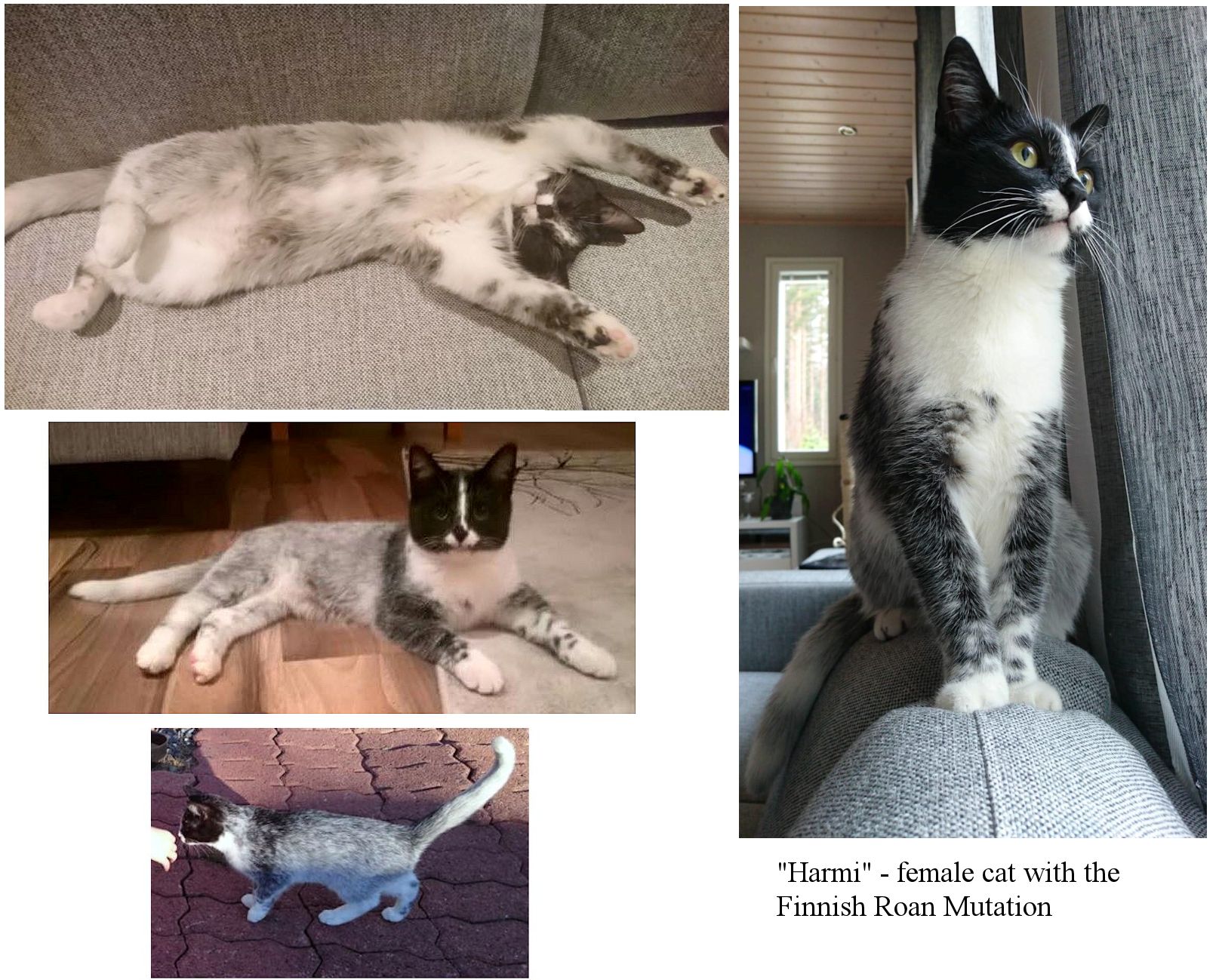
The next Finnish mutation cat was reported around 1000km away in Nizhny Novgorod, Russia to unknown parents and was reported in November 2017 by Natalia Border-Rottys who took some photos of the cat at a show. He was shown as a neutered household pet. Once again the legs and tail are pale and dappled, the torso is black roan and the head is black with a white blaze and black nose.
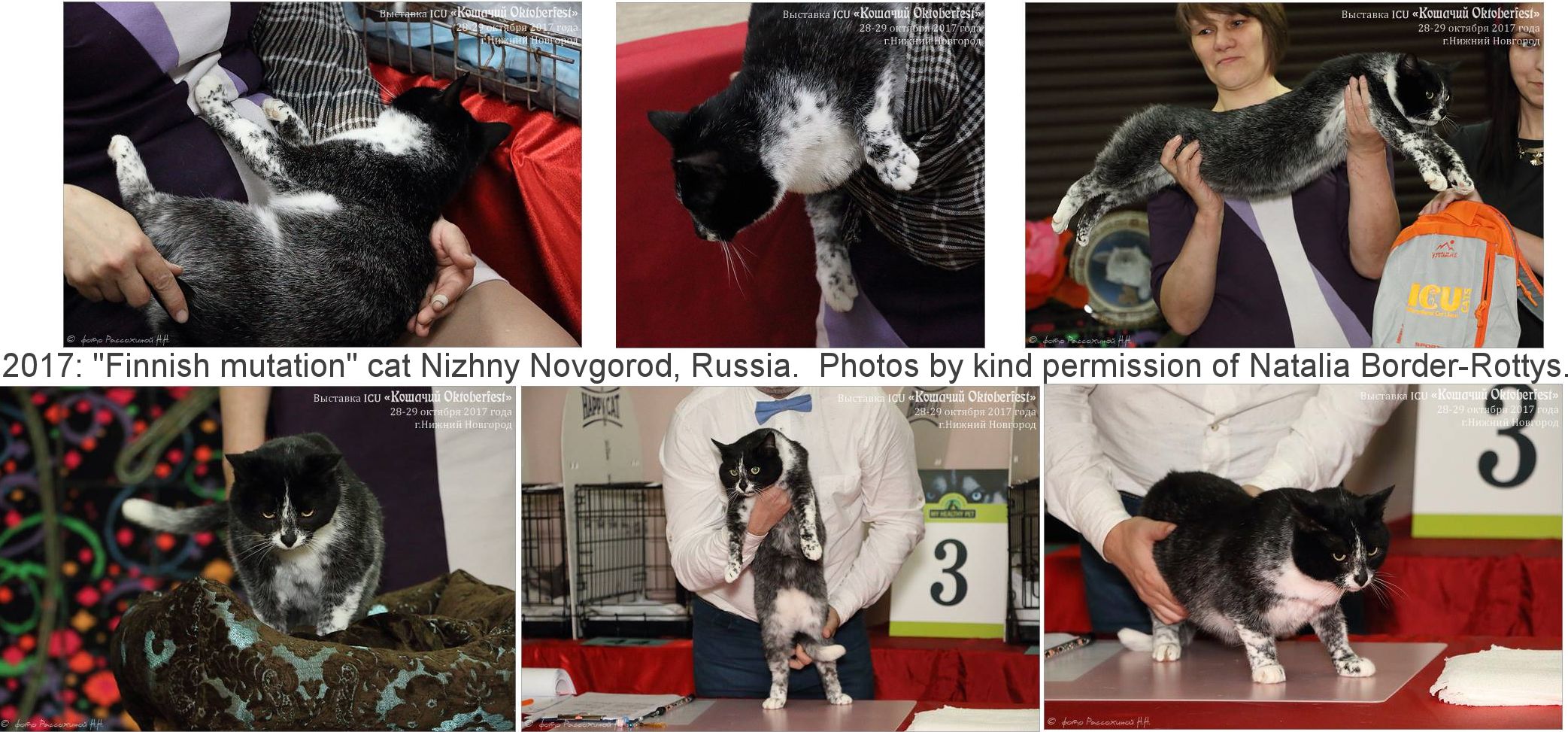
Another cat similar to Kuuru was found by Gertrude Hainzl in Hungary.
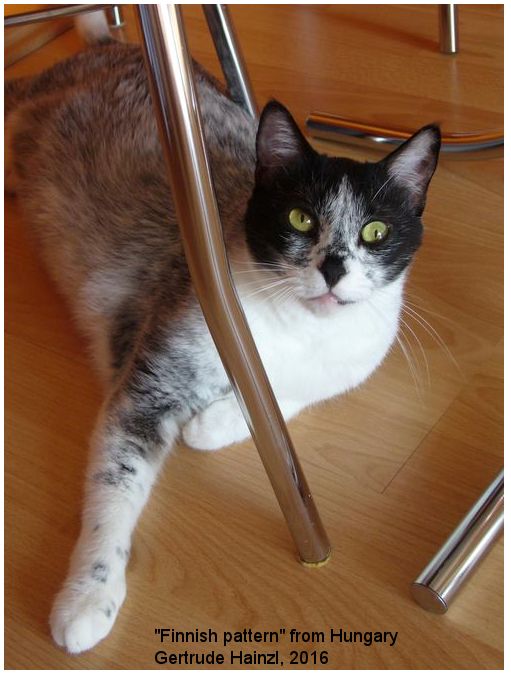
2019 – "FINNISH MUTATION" IN THE NEWS
"Harmi" was featured on the Finnish news website ILTAHLEHTI on 25th September 2019 (revised 5th May 2020) in an article by Liisa Lahti. This is a translated summary (much of the information comes from myself).
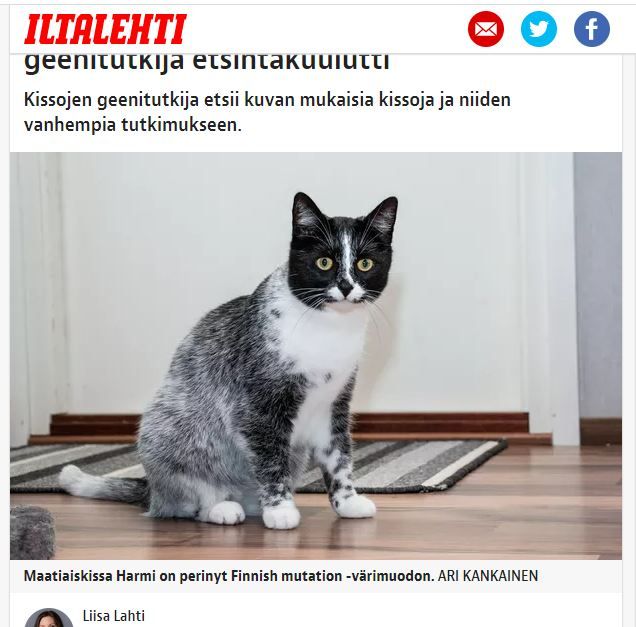
If you have a cat that looks like the one in the picture above, you are sharing your home with a domestic rarity. The cat in the picture gets it coat colour due to a rare gene mutation. The mutation is found only in Finland except for one individual in Russia. The colour pattern has been found mostly in feral cat populations trapped in central Finland. It is known to occur only in non-pedigree cats. It is possible that all cats with this pattern are descended from the same population. In the Finnish mutation pattern, the black colour areas of the black and white cat have faded to grey except for the head. The legs are grey spotted and there is a white area on the face. Cats with this pattern, and cats that have produced offspring with this pattern, are now being sought for research at the University of Helsinki.
The Finnish mutation pattern is recessively inherited, so it requires the genetic mutation to be inherited from both parents. The gene mutation is hidden in the parents. A recessive pattern can be carried a long way in cat generations without showing up, said Milla Salonen, PhD researcher at the University of Helsinki. She added that cats who have inherited the Finnish mutation pattern are believed to be unable to reproduce but this is not confirmed because all known cats that have inherited the gene mutation came from wild populations and were neutered without having had the opportunity to reproduce.
Salonen and her colleagues have sent a DNA sample from Harmi to Genoscoper for the MycatDNA test to find out information about its inheritance. They want to identify the specific gene region that causes the mutation. They believed that because the pattern and colour is so similar in all known examples it may be a single gene with just a single base change.
The news article said that it wasn't known if cats with this mutation occurred in other colours. However a red karpati LaPerm with the "Finnish" pattern has occurred.
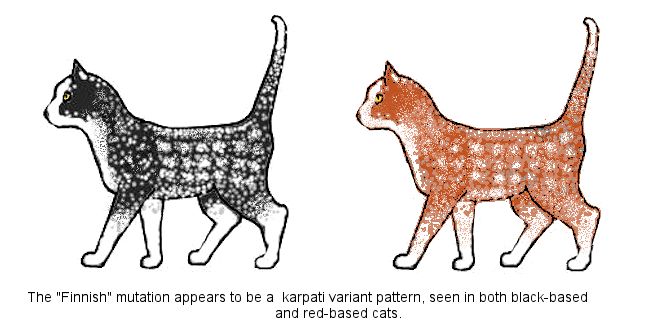
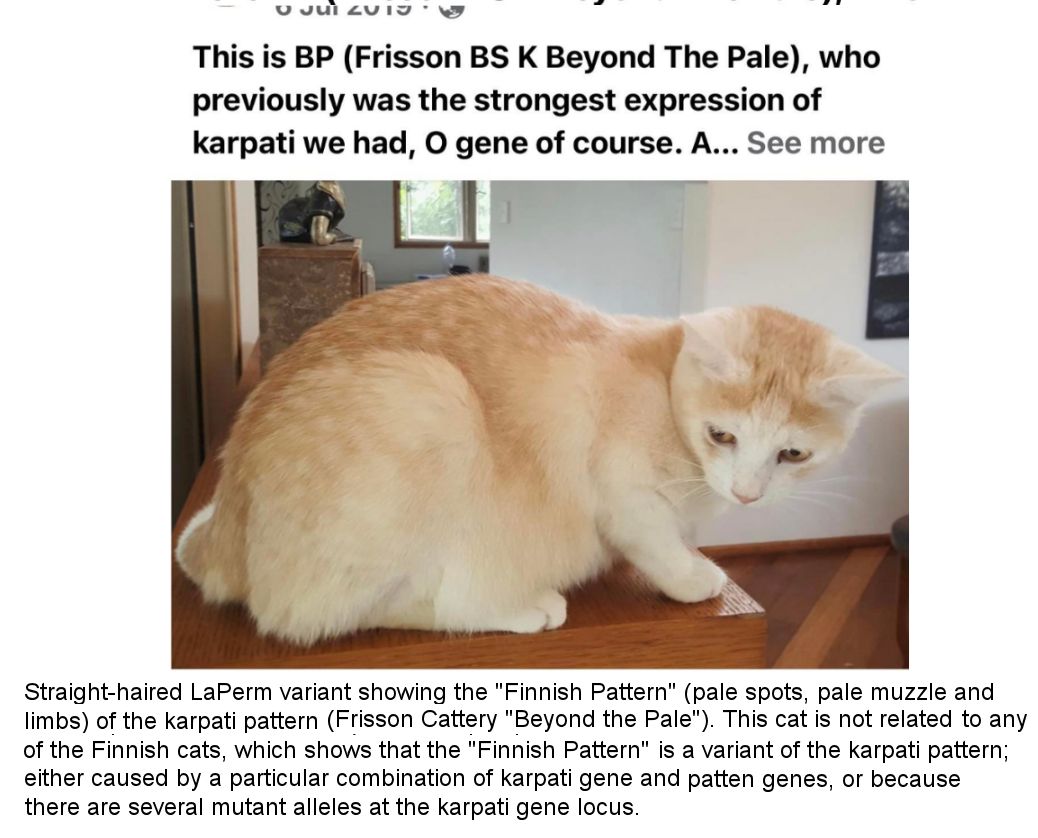
2024 – SALMIAK GENE IDENTIFIED
A new Finnish flavor of feline coat colouration, “salmiak,” is associated with a 95-kb deletion downstream of the KIT gene.- Heidi Anderson, Milla Salonen, Sari Toivola, Matthew Blades, Leslie A. Lyons, Oliver P. Forman, Marjo K. Hytönen, Hannes Lohi
Based on the unique appearance of the cats and their Finnish origin, researchers named this pattern “salmiak” after Finnish traditional salty licorice. Four salmiak colour cats were tested for known white spotting variants found on the KIT gene. They were negative for dominant white (W), white spotting (Ws) and Birman white gloving (wg) genes. Genome sequencing found that salmiak pattern cats were homozygous for a large deletion downstream of the KIT gene. The new mutation was given the symbol Wsal. The gene is an autosomal recessive, although heterozygous cats are reputed to have some white in their coats.
Salmiak pattern is most noticeable in solid black cats, but can occur with different colours, and with tabbies and tortoiseshells. It occurs in both male and female cats. This white spotting variant does not appear to affect hearing. The suggestion of infertility was refuted when a salmiak female produced kittens (the infertility was most likely due to inbreeding).
Two karpati pattern cats were also tested and neither had the salmiak gene. (Note: Vampira, the salmiak pattern cat bred from karpati parents was not one of the cats tested. It is possible that both parents carried the recessive salmiak gene and that related cat “Frisson Beyond the Pale” was salmiak pattern. Vampira initially developed a normal karpati pattern, but had the salmiak pattern as an adult.)
Anderson, H., Salonen, M., Toivola, S., Blades, M., Lyons, L.A., Forman, O.P., Hytönen, M.K. and Lohi, H. (2024), A new Finnish flavor of feline coat colouration, “salmiak,” is associated with a 95-kb deletion downstream of the KIT gene. Anim Genet. https://doi.org/10.1111/age.13438
2023 – RELATIONSHIP TO KARPATI PHENOTYPE?
Terri Hunt and her sister, Janet Michael, of Brisbane, Australia breed karpati-pattern Sphynx, mostly naked Sphynx, but sometimes haired variants. Their karpati Sphynx breeding line is Soul Sphynx and they have bred Sphynx for almost 20 years. They acquired a shorthaired black-tabby-and-white karpati patterned male they called Frigg as an outcross for their Sphynx lines to introduce genetic diversity and to see how the pattern manifested on the skin or peach-fuzz of Sphynx cats.
In 2023 they posted photos of Vampira, a shorthaired Sphynx variant with a pattern almost identical to the Finnish cat Kuuru. Vampira had been DNA tested and was non-agouti (solid black), homozygous for the mackerel tabby gene and homozygous for the karpati gene. This combination of genes appears to have created the dark head, roan torso, pale extremities and, importantly, the impression of white spots on the torso. Vampira's parents will be mated again to see if further white-spots-on-black-roan offspring are born.
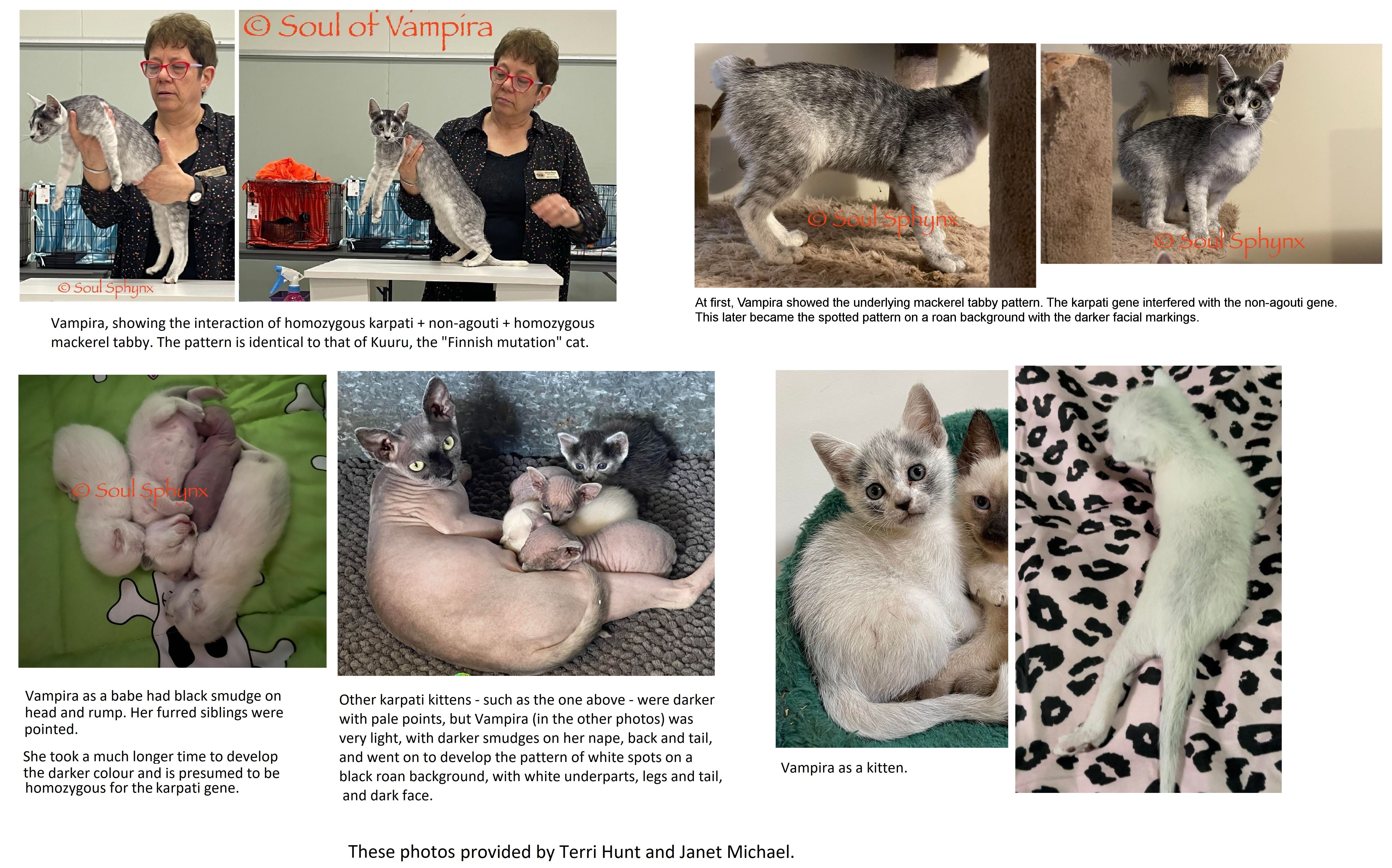
The photos show Vampira and her siblings. Vampira was born very pale, with grey smudges on her nape, back and tail; she went on to develop the pattern of white spots on a black roan background, with white underparts, legs and tail, and dark face. A comparison photo shows a more typical karpati kitten that is black roan with pale points (the ears are visibly much paler).
Vampira's mother is a nude black karpati pattern Sphynx and her father is a coated black karpati Sphynx variant. At birth, Vampira was already much lighter in colour from all the other black coated karpati variants, suggesting she is homozygous for the karpati gene. It took her much longer to get her black coat. It is possible that there are multiple alleles of the karpati gene that can cause different patterns depending on which combinations are inherited. Normal karpati (with roan expression) is a dominant, temperature sensitive mutation, though the variable expression suggests cats with one copy of the gene are born a darker roan than those with two copies. It appears that karpati interferes with the non-agouti gene. Vampira has the white-spotted pattern.
Vampira is homozygous karpati + non-agouti + homozygous mackerel tabby.
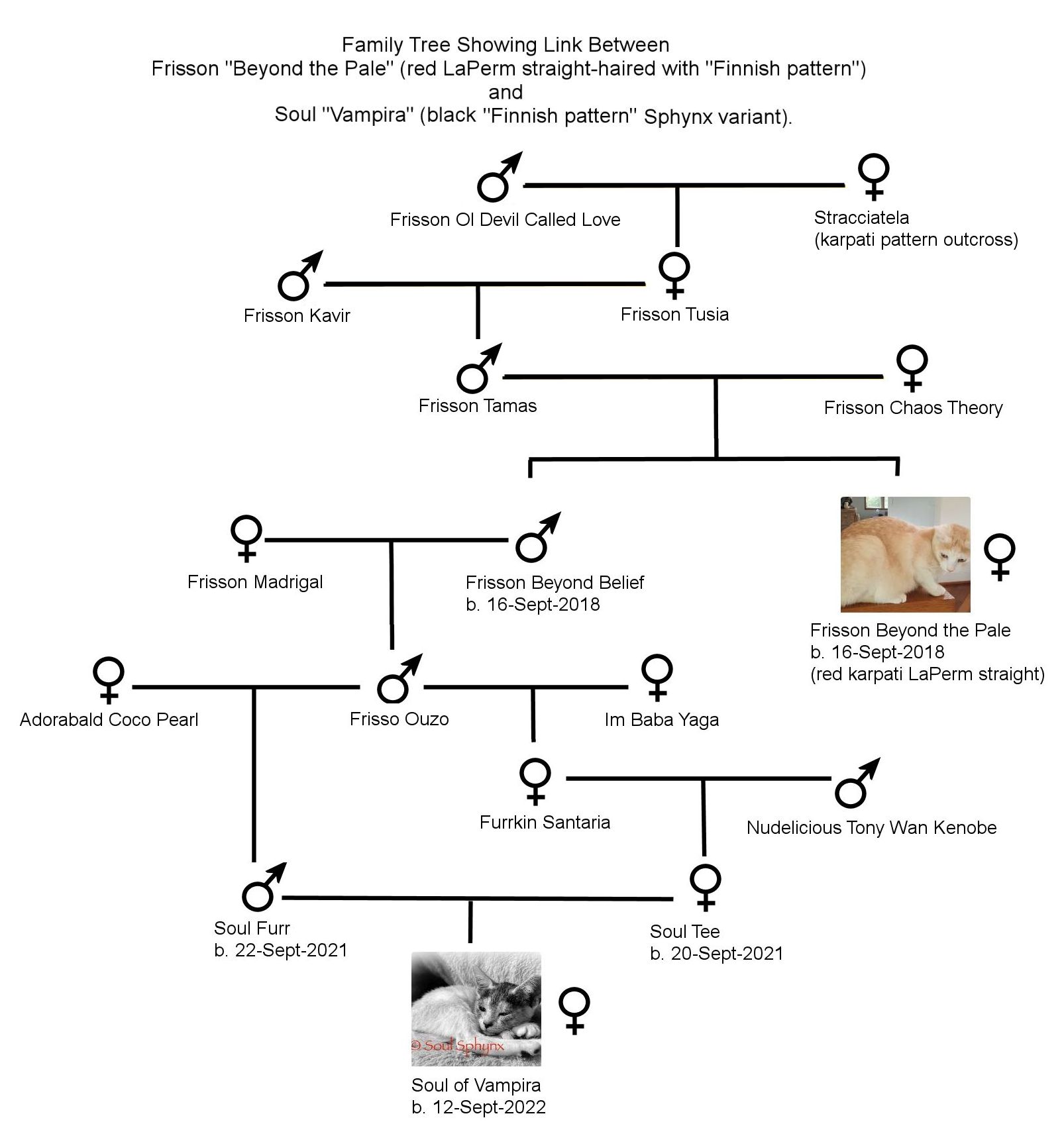
Frigg was their first karpati pattern cat, black karpati tabby and white, but they decided not to breed from him in case the 2hite markings and tabby pattern confused the the karpati expression. Instead they obtained a chocolate karpati male Beans (Frisson Ouzo, straight-haired LaPerm variant) who became the ancestor of all their karpati. Terri and Janet are also trying to breed a blue karpati nude to show people the difference between the black and blue karpati nudes; the black nudes are often mistaken for blue.